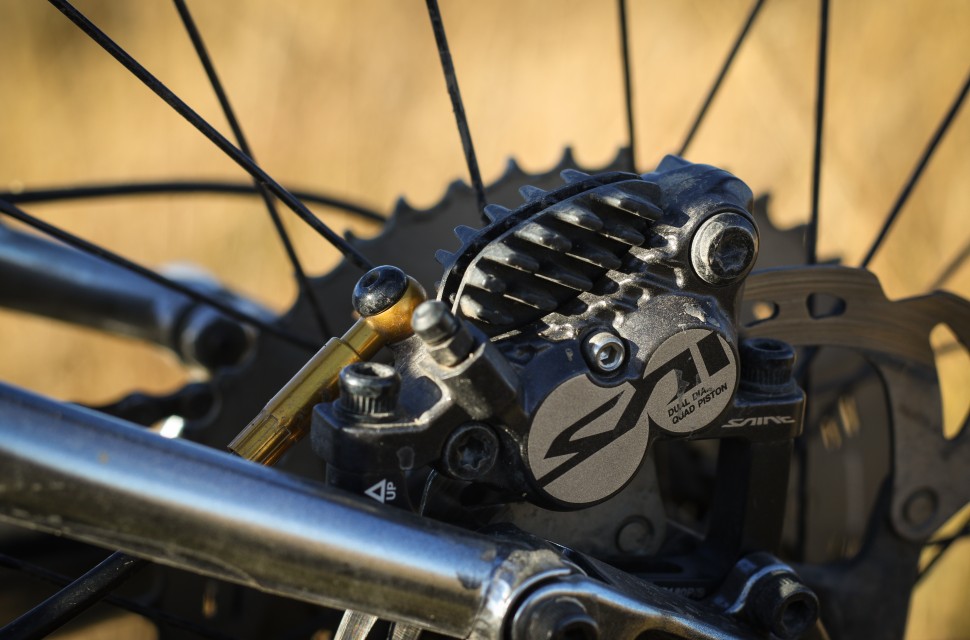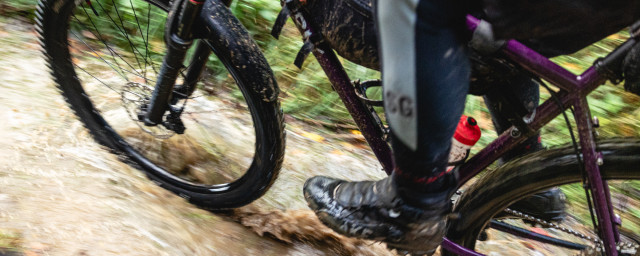
- Powerful brake
- Ergonomic lever feel
- Dissipate heat very well
- Some bite point inconsistencies
The Shimano Saint M820 hydraulic disc brakes are a superb, powerful and a mostly reliable brake. They are good value given the stopping power on offer and they look pretty sweet too!
- Review - TRP G-Spec Quadiem disc brakes
- Review - SRAM Code RCS disc brakes
- Interview - Shimano European Product Manager on the new XTR
The Shimano Saint line up is, to put it simply, the downhiller’s component choice. With my long term test bike, a Cotic Rocket, built up to be an all mountain, gravity fed machine rather than a light weight, mile muncher, they seemed the perfect match. Lever and calliper without disc weigh 595g, not light but I’m no weight weenie either.
My set up saw Saint levers and the four pot callipers matched up with 203mm Ice Tech rotor up front and a 180mm on the rear. Per end that’s £179.99 plus £59.99 per disc, adding up to £479.99. It sounds a lot but it would be £544 for the equivalent SRAM Code RSC’s. The price above refers to one brake, one IceTech disc and a brake post mount.
The brake levers feature free stroke adjustment which I found not to be very effective, there is also reach adjust which is tool less and easy to use. Plus, the levers are i-spec compatible meaning you can bolt a Shimano shifter on for a neat uncluttered bar. The calliper, as previously stated, has four pistons which are ceramic to help with heat dissipation. The set will come fitted with finned pads for heat management, these have been pretty long lasting over the dry summer period we experienced and still have life left into the winter. The Ice Tech discs are designed to dissipate heat and maintain braking performance, something that the set up does very well, I didn’t have any problems with overheating brakes or loss of power.
The Saint lever is ergonomically nice to use, I like the shape of the small lever blade, my forefinger sits securely in the crook at the end of the stubby lever, grip further maximised by the dimple pattern on the outer edge. The lever throw is on the most part short but there is some vagueness and an inconsistency in the bite point on occasion. It isn’t present as often or as dramatically as previous pairs of XT and SLX brakes I have used but it’s certainly there, with the lever pulling further towards the grips in the first instance of use, a problem fixed by pumping the lever repeatedly or bleeding the brake. The inconsistency wasn’t irregular enough to worry me or knock braking confidence though.
There could be some criticism of the Saint’s being ‘grabby’ but it doesn’t take long to modulate your own forefinger to apply the correct amount of pressure to the lever and scrub speed consistently and quickly and I got on well with them once I had adjusted.
The raw power on offer from the Saint’s is spectacular, it’ll be the only thing you think about. That power, plus some of the best cooling tech on the market is the reason to buy the Saint brakes.
You might also like:
- What's the best way to clean disc brakes on a bicycle?
- 11 tools every home bike mechanic should own
- Best mountain bikes for under £3,000 - capable trail bikes that won't break the bank
















Add comment